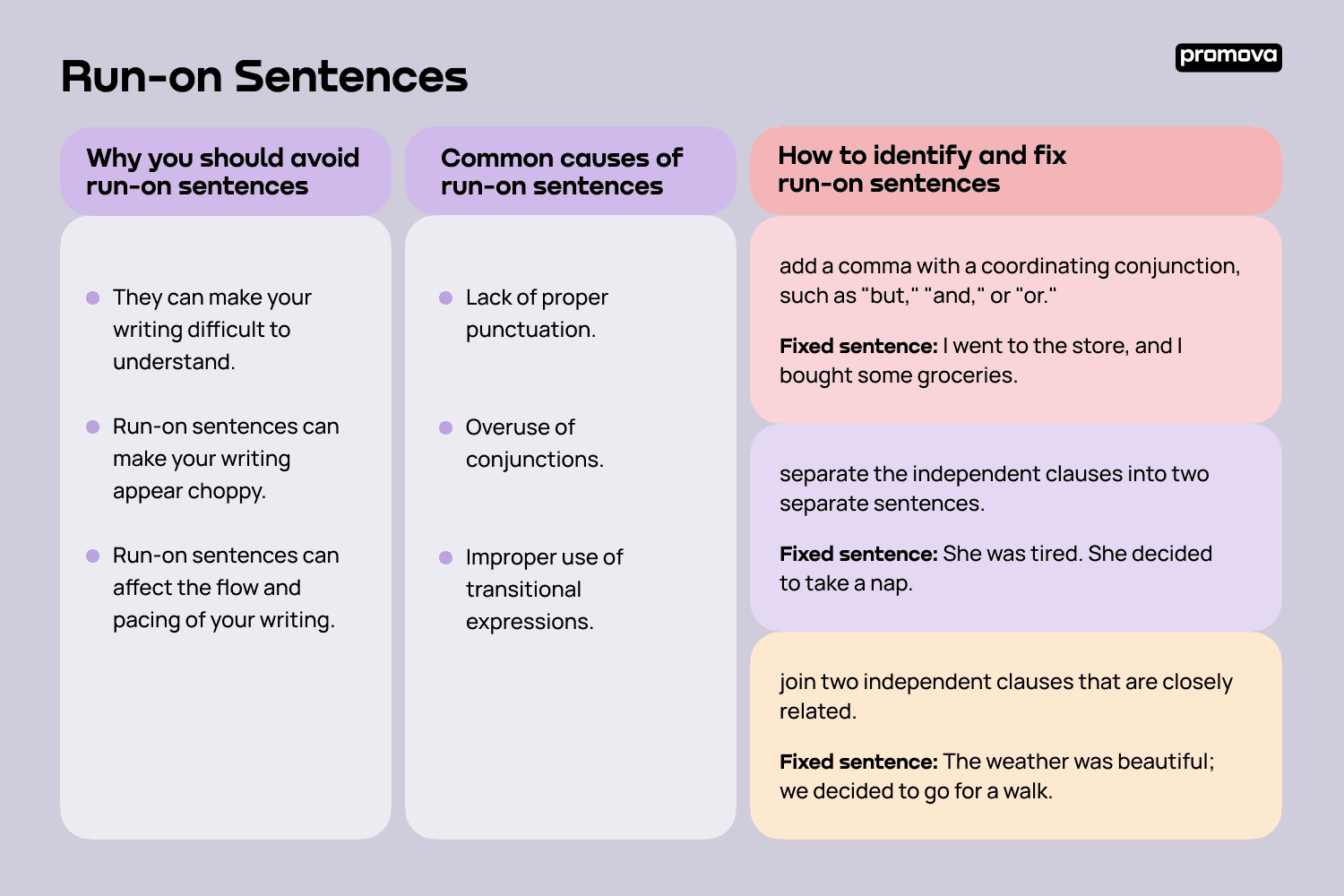Run-on Sentences
Contents
In this reference, we will define a run-on sentence, explain why they are problematic, explore the common causes of run-on sentences, and provide tips on how to identify and fix them. We will also touch on other common mistakes with sentences and correct punctuation. By the end, you will be equipped with the knowledge and tools to write clear and effective sentences.
What is a run-on sentence? Definition and examples
A run-on sentence is a sentence that includes of two or more independent clauses that aren't properly joined or separated. An independent clause is simply a clause that can be its own sentence. When two of them are put together without proper punctuation or conjunctions, the resulting sentence is a run-on sentence.
For example:
Run-on sentence: I went to the market I bought some groceries.
This sentence consists of two independent clauses, "I went to the market" and "I bought some groceries." However, there is no proper punctuation or conjunction separating them, making it a run-on sentence.
Another example:
Run-on sentence: She was tired she decided to take a nap.
This sentence also consists of two independent clauses, "She was tired" and "She decided to take a nap." However, they are not properly joined or separated, making it a run-on sentence.
Why you should avoid run-on sentences
Run-on sentences can be problematic for several reasons.
- They can make your writing difficult to understand. When two or more independent clauses are combined into one sentence without proper punctuation or conjunctions, it can be confusing for the reader to determine where one thought ends and another begins.
- Run-on sentences can make your writing appear choppy. Writing is often judged not only on the content but also on the ability to convey that content in a clear and organized manner. Run-on sentences can make your writing appear disorganized and sloppy.
- Run-on sentences can affect the flow and pacing of your writing. When a sentence is too long, it can be difficult for the reader to keep track of the main idea. This can lead to confusion and a lack of engagement with your writing.
Common causes of run-on sentences
There are several common causes of run-on sentences.
- Lack of proper punctuation. Without it, it is difficult to determine where one independent clause ends and another begins.
- Overuse of conjunctions. While conjunctions can be useful in joining independent clauses, they should be used sparingly. Overuse of conjunctions can result in run-on sentences.
- Improper use of transitional expressions. While transitional expressions can be useful in guiding the reader through your writing, they should be used in conjunction with proper punctuation and conjunctions.

How to identify and fix run-on sentences
The first step in identifying run-on sentences is to read your writing out loud. This will help you to hear where the independent clauses end and where the proper punctuation or conjunctions should be added.
Once you have identified a run-on sentence, there are several ways to fix it. One way is to add a comma with a coordinating conjunction, such as "but," "and," or "or."
For example:
Fixed sentence: I went to the store, and I bought some groceries.
Another way is to separate the independent clauses into two separate sentences.
For example:
Fixed sentence: She was tired. She decided to take a nap.
Finally, you can use a semicolon to join two independent clauses that are closely related.
For example:
Fixed sentence: The weather was beautiful; we decided to go for a walk.
1
Other common mistakes with sentences
In addition to run-on sentences, there are several other common mistakes that writers make with sentences. One is the use of sentence fragments. A sentence fragment is an incomplete thought that doesn't have either a subject or a verb.
For example:
Sentence fragment: Running through the park.
This sentence is missing a subject. A corrected version would be:
Corrected sentence: I was running through the park.
Another common mistake is the use of passive voice. In it, the subject of your sentence receives the action rather than performing it.
For example:
Passive voice: The ball was thrown by John.
In this sentence, "the ball" is receiving the action of being thrown rather than performing the action. A corrected version would be:
Corrected sentence: John threw the ball.
Correct punctuation
Proper punctuation is essential for clear and effective writing. In addition to using punctuation to separate independent clauses in a run-on sentence, there are several other rules to follow.
First, use a comma after introductory words or phrases.
For example:
Correct: After finishing my homework, I went to bed.
Second, use commas to separate items in a list.
For example:
Correct: I need to buy eggs, milk, and bread at the store.
Finally, use a period at the end of a sentence.
For example:
Correct: I am going to the store.
Summary
Run-on sentences affect the pacing of your writing and make it hard to understand. However, by identifying the common causes and using proper punctuation and conjunctions, you can easily fix this problem. Remember to read your writing out loud, and if you are unsure about the correct punctuation, consult a grammar guide or writing resource. On that note, check out more handy resources for English learners below!
Comments